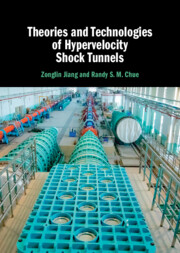Book contents
- Theories and Technologies of Hypervelocity Shock Tunnels
- Theories and Technologies of Hypervelocity Shock Tunnels
- Copyright page
- Contents
- Preface
- 1 Introduction
- 2 Shock-Wave Relations and Aerothermodynamic States
- 3 Heated Light-Gas High-Enthalpy Shock Tunnels
- 4 Free-Piston-Driven High-Enthalpy Shock Tunnels
- 5 Detonation-Driven High-Enthalpy Shock Tunnels
- 6 Theory and Methods for Long-Test-Duration Shock Tunnels
- 7 Methods for Designing High-Enthalpy Flow Nozzles
- 8 Aerothermodynamic Testing and Hypersonic Physics
- Index
- References
3 - Heated Light-Gas High-Enthalpy Shock Tunnels
- Theories and Technologies of Hypervelocity Shock Tunnels
- Theories and Technologies of Hypervelocity Shock Tunnels
- Copyright page
- Contents
- Preface
- 1 Introduction
- 2 Shock-Wave Relations and Aerothermodynamic States
- 3 Heated Light-Gas High-Enthalpy Shock Tunnels
- 4 Free-Piston-Driven High-Enthalpy Shock Tunnels
- 5 Detonation-Driven High-Enthalpy Shock Tunnels
- 6 Theory and Methods for Long-Test-Duration Shock Tunnels
- 7 Methods for Designing High-Enthalpy Flow Nozzles
- 8 Aerothermodynamic Testing and Hypersonic Physics
- Index
- References
Summary
The achievable total enthalpy and the pressure level in a shock tunnel depend on its capability to generate strong shock waves. To produce a strong shock wave, high pressure and high sound speed are two key parameters for driver gases. There are various techniques to increase the driver gas sound speed, which are essentially different approaches in the way to raise the driver gas temperature. The first technique to increase the driver gas sound speed is by the use of a light gas, and the second one is by heating the light gas to a high temperature with gas heaters. The light-gas-heated shock tunnel is introduced in this chapter, and the electrical heaters are discussed in detail, including the relatively simple electrical resistance heaters and electric-arc heaters. Strictly speaking, the electric-arc heating is not a gasdynamic technique and it is not capable of completing flight-condition duplication for hypervelocity testing. However, it is selected because it can generate extremely high total enthalpies and is useful in certain applications.
- Type
- Chapter
- Information
- Theories and Technologies of Hypervelocity Shock Tunnels , pp. 54 - 72Publisher: Cambridge University PressPrint publication year: 2023



